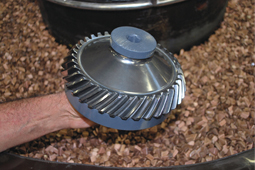Isotropic Superfinishing

Isotropic Superfinishing can be used to reduce surface finish to as little as 2 RA.
More Information
One of Arrow's systems features an extra large capacity and can accommodate 25 inch diameter parts and shafts with lengths of 50 inches. This size capability is relatively rare in the gear manufacturing industry.
The Importance of Isotropic Superfinishing
The surface finish of gear teeth is directly related to the service life and overall quality of aerospace gearing. For this reason, Arrow has added the capability of Isotropic Superfinishing.
When metal components come into contact with each other, contact stresses and friction occurs which directly impacts performance, and in time, will eventually compromise the components.
This is of particular concern with aerospace gearing applications, in which high contact stresses are present and high fatigue life is a requirement. By improving surface finish with the superfinishing process, stress concentrations and wear can be significantly reduced.
To achieve an optimal surface finish on gear teeth, grinding of the gear teeth has historically been the chosen manufacturing process. However, as the demands of aerospace systems become more advanced, the process of superfinishing has become a more common specification.
With tooth grinding, the resulting gear tooth finish is typically 16 RA, or 16 micro inches. With the superfinishing process, surface finish can be reduced to as little as 2 RA. This substantial reduction has a direct benefit on the life of the gear. According to NASA testing, this type of surface finish reduction can increase the life of the gear up to 300% through the reduction of friction and increased rolling contact fatigue life.
The superfinishing process is performed by placing parts in a bin which contains a mix of ceramic and plastic media of different sizes and shapes, as well as a chemical additive. A vibratory action is then used to complete the process.

